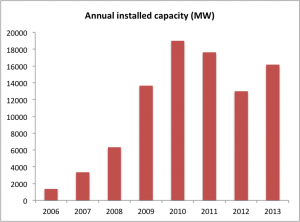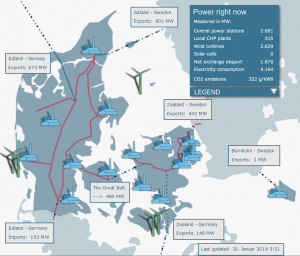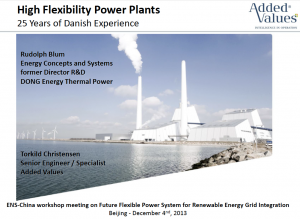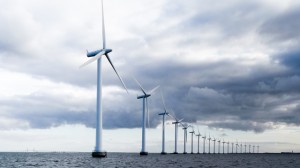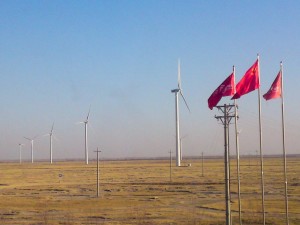“China will promote green power dispatch, giving priority, in distribution and dispatching, to renewable power generation and fossil fuel power generation of higher efficiency and lower emission levels”.
These are the words in the U.S.-China Joint Presidential Statement on Climate Change that was released during President Xi’s visit at the White House on 25 September. And this is good news for integration of renewable energy in China. The curtailment of wind and solar power is a big problem for the further development of renewable energy, a waste of money for the society, and it creates local and global pollution, which could have been avoided.
However, the implementation of the priority dispatch is crucial for the success. It is not sufficient just to give orders to the Chinese dispatch centres to give priority to renewable energy (RE); it will only put the dispatch operator in an situation, where they have conflicting goals to fulfil without any real change to implement an efficient dispatch. Instead, a number of measures should be taken into play to ensure that all stakeholders pull in the same direction.
In my mind a coordinated action plan is necessary to ensure a proper green power dispatch. Here is my take on the elements in such a plan:
1. Stop for new coal fired power plat from 2020 and slow the pace before that
Firstly it should be clear, that there is not need for new coal fired power plant in the long run if China wants to have a sustainable energy system. Already today too many new coal-fired power plants are being build. The slow-down in electricity consumption growth is not a temporary issue – it’s also part of the long-term transition of the Chinese industry from heavy industry to light industry and services. And still coal fired power plants are being build at the same pace as before, resulting in significantly lower utilisation of the capacity, but also putting pressure on the use of power from renewables. So latest by 2020 new coal fired power plants should be banned. It should be decided now in order to give the industry sufficient time to change direction, and a strong cap for new coal power plants should be in place soon in order to slow down the pace until the full-stop in 2020.
2. Remove the priority dispatch for power plants
Today, in many provinces the coal fired power plants have a de facto priority in the dispatch by having the right to produce a certain amount of hours each year, the so-called “planned full-load hours”. These full-load hours are strong guidelines for the dispatch operators in the daily dispatch and by the end of the year the planned full-load hours should be fulfilled for each power plant. The rights were introduced to ensure the economic viability of the investments in new power plants in a situation where there were a strong need for new capacity due to soaring power consumption. Today, these rights gives a strong disincentive for integrating renewables and strong disincentives for the coal power plants to operate in a flexible way. Therefore the rights should be removed, and it seems reasonable to start with the old power plants which should have been able to have a reasonable pay-back time. It could be for power plants build before 2000.
For the power plants build after 2000 it might be difficult in one step to remove the right to produced a certain amount of hours for economic reasons. But the physical right to produce could be substituted by e.g. tradable production rights, which could allow for others, including new wind farms and solar power plants to have access to the dispatch. But of course other compensation mechanisms could be used instead, and most importantly, the compensation should be reduced gradually.
3. Loosen the ties between heat and power production
Combined production of heat and power is an efficient way to utilise the fuel, but when the power production from coal fired combined heat and power plants (CHP-plants) substitutes power from wind and solar, it’s less efficient, more polluting and more expensive than letting heat-only boilers cover the heat demand. Therefore, loosen the ties between heat and power production when there is sufficient power production from renewables to cover the consumption. Large heat storages at the CHP-plants will allow for more flexibility, and they can also be used to convert electricity to heat, if the production from variable power production is bigger than the consumption. But it should also be allowed to use efficient heat-only boilers, it should be encouraged to introduce large solar heating plants as part of the heating system etc. Flexibility is the keyword here.
4. Make the grid work for integration of variable power production
Today the dispatch of the interconnectors between provinces and between power regions are not very flexible, which is a major barrier for RE-integration. Therefore, flexible use of the existing transmission grid is a precondition for a priority dispatch of RE. The exchange of power from one province to another should be part of the daily dispatch, not determined by long-term, inflexible agreements and settlements.
Furthermore, a plan for a rapid and strong expansion of the regional interconnectors should be set-up, based on systematic assessment of the potentials for deployment of RE power production. This would ensure a much better use of the variable power production through the “smoothing effect” of larger system areas and the better relation between power production and power demand in larger regions.
Finally, it is necessary to re-evaluate the strategy for long-distance high-voltage transmission lines. Currently these lines are primarily designed for base-load operation, which creates in-flexibility both in the supply end and the receiver end of the lines. Also the long-distance transmission lines should be dispatched according to the daily needs for matching production and consumption on an sub-hourly basis.
5. Encourage demand side flexibility and promote storage technologies
The variability of the power production from wind and solar is a challenge for the integration of RE, which in the short run can be solved by the above mentioned measures. However, a more flexible use of electricity and introduction of electric storage will in the long run be part of the solution. Therefore, economic incentives for flexible use of electricity should be introduced; plans for rapid development and deployment of electric vehicles should be prepared – with incentives for flexible charging; and R&D support for long-term development of electric storage should be encouraged.
6. Introduce a national-wide power market as tool for green power dispatch
Introduction of a Chinese power market is the last of my bullet point. Not because it is the least important measure, on the contrary; a well-design power market would be the right tool to ensure the implementation of the other measures. A dynamic price-setting of power production would create economic incentives for the power generators to operate their power plants in a flexible way; it would give incentives to flexible use of electricity; and it would take care of the daily dispatch based on least-cost principles. Combined with a carbon tax (or by an efficient implementation of a carbon emission trading system) it would be sufficient to create a green dispatch. One the other hand it is clearly a long-time project to create an efficient national-wide power market, while most of the other measures could be implemented immediately or in a shorter time horizon, so there is no reason to wait for power market to start getting greener in the dispatch.
See more about renewable energy in China on boostre.cnrec.org.cn



